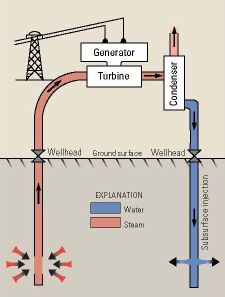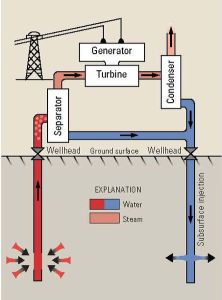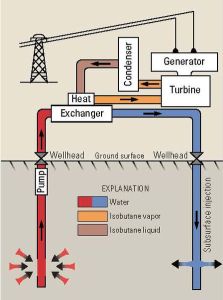| Dry
Steam
Power
Plants Dry steam power plants tap into huge underground steam pockets. The steam is very hot, and rises up the well. It is piped directly to a turbine, which drives a generator, and produces electricity. The steam cools as it circulates through the system, and condenses, and the water is injected back into the ground. The steam powers itself, so no energy is needed to drive the system. This makes it more economical to start-up, and operate, and the simple machinery keeps operating and repair costs low. |
 click photo to enlarge photo source |
| Flash
Steam Power Plants Flash steam power plants use a similar set up to the dry steam power plant, except that they draw extremely hot liquids from the ground, rather than steam. The liquid is highly pressurized, and is easily drawn up the well. It enters a low pressure tank, and is forced to vaporize. As with the dry steam plant, the steam then turns a turbine, which drives a generator to produce electricity. The condensed water is returned to the ground. This system is more complicated than the dry steam plant, and therefore costs more to initiate, operate, and maintain. It has a lower monetary return for the investment, compared to the dry steam plant. |
 click photo to enlarge photo source |
| Binary
Cycle
Power
Plants This is the most complicated system, and the riskiest investment. As can be seen in the pictures, there is a lot more going on with this power plant. It doesn't require super heated liquid, or steam pockets, and therefore can be used in a wider range of locations. This plant operates with moderate temperatures. The underground liquid is pumped to a heat exchanger, and then returned to the ground. The heat exchanger contains a fluid with a low boiling point. Low enough that the warm liquid is able to heat it to boiling, and it vaporizes. The steam from this second fluid is what turns the turbine, and drives the generator to produce electricity. There are two separate systems working at this plant; it costs more to build, operate, and repair. It is less efficient, creates less power, and is more vulnerable to geologic changes. If the temperature of the underground liquid drops, the whole system may have to be reworked, or it may no longer work at all. It is also difficult, or impossible, to predict how much hot liquid is available, so this is a risky investment. However, of the three systems this has the most lenient heat requirements, and it can be set up over much of the planet. This may be the dominant geothermal plant in the future. |
 click photo to enlarge photo source |
 HOME HOME |
 GEOTHERMAL GEOTHERMAL |
 CO2 SEQUESTRATION CO2 SEQUESTRATION |
 REFERENCES REFERENCES |